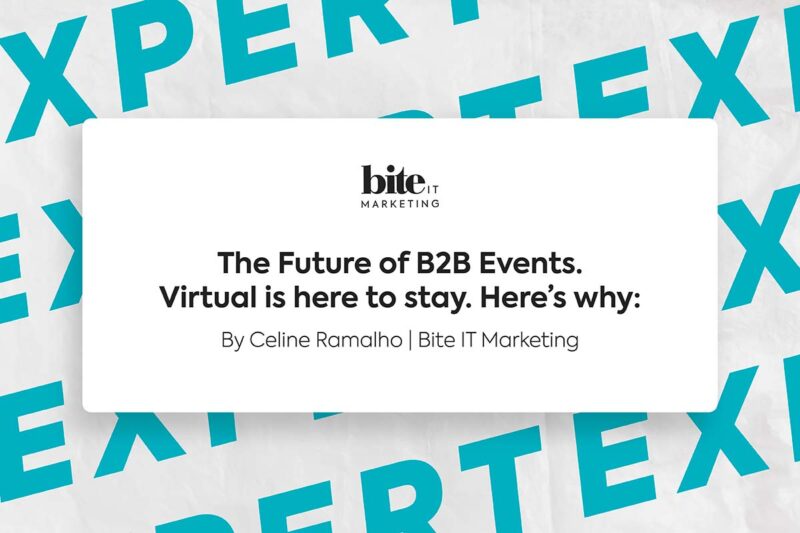
The Future of B2B Events
By Celine Ramalho, Bite IT Marketing
There was an 80% fall in B2B event spend during Q2 of 2020 as a result of the onset of the pandemic. With COVID-19 throwing a spanner in our marketing plans and more specifically with our physical B2B events, marketers all around the world are now slowly wondering what the future has in store for events and if they will ever be back “like before”. Physical events are coming back but mostly only on a small scale. Large scale global events are not expected to be back for another 12-18 months or so.
In our view, virtual events are here to stay for a myriad of reasons. These include:
- Reduced cost when compared to large in-person events
Online events don’t require expensive reservations at fancy hotels or conference centres. They also do not require attendees to purchase plane tickets to fly to a location or book hotel rooms for accommodation. Both organisers and attendees save lots of money with online events. Whereas event organisers previously would’ve had to charge higher fees to attendees to cover overhead costs, the reduced cost to host events means that the price to attend them can also be reduced. This provides greater accessibility to an even wider range of people that may have interest in an event.
- Greater convenience for working parents and professionals with busy lifestyles
No longer do working parents or extremely busy professionals e.g. C-suite executives need to schedule time away from their family/work to attend a conference. Now, they can tune in online and participate while on their school run in the morning or during the midday lunch break.
- Environmental sustainability
Physical events generate significant human waste; whether that be the burning of fossil fuels for transportation to the venue (planes, cars etc.), the creation of single-use conference/event marketing material which is oftentimes discarded after the event as well as the illegal dumping/littering of waste often perpetrated in small amounts by individual attendees. All these factors can be mitigated with online conferences.
- Greater reach/accessibility
Live streamed events can be accessed by anyone across the world once they have a stable internet connection. This greatly increases the number of potential attendees organisers can market to. Hosting events online has virtually removed all limitations in terms of event attendee capacity. Furthermore, the fact that most online events are recorded means that people can now watch at their own convenience, even after the event has passed.
- More optimised lead generation
Virtually all browsing activity online can be tracked and used for remarketing purposes. Online B2B events are no different. Whether someone simply visited a promotional landing page for the event, submitted a form to get notifications about the event or purchased tickets, all this information can be used to guide follow-up direct-mail, emails, calls and PPC campaigns to further target this audience which has already expressed interest in the product/service associated with the event.
Tips to make virtual events more relevant and engaging
Go Live!
There is nothing as compelling as a live session. It’s not enough to just show up with a webinar login anymore. If you are asking people to take time out of their professional lives – you need to show up as well. And while pre-recorded content makes life easier from a scheduling and production standpoint, there is nothing as compelling as a live session. The good news for all of us perfectionists out there is that virtual event attendees are willing to forgive a few tech glitches in favour of raw, real-life moments – warts and all.
Gamification of virtual events – interactivity is the key. People are more likely to stay focussed if they’re involved in the action. Activities can be introduced which allow delegates to earn points. Winners can be ranked and prizes may be offered to make events as interactive, enticing and exciting as possible. Entertainment can also be interactive, e.g. wine tasting, a collective coffee morning etc. to give attendees a more personal/tangible experience than simply looking at a screen.
Keep it snappy – ideally each speaker/session should be about 5-6 mins. If necessary, have a variety of shorter sessions rather than one or two lengthy sessions as those may cause people to switch off.
Keep it different and make it bespoke – if everyone is using online magicians, do something else! Pretty much any act in the real world will work online with a bit of thought. Acts should also tailor their performance to make it relevant to the audience/company which keeps it interesting for everyone. Virtual venues that match the event theme/wider season are also great ideas to keep the online environment fresh and interesting. For example, you may consider hosting your December events from a virtual alpine lodge!
Make it real/tangible – instead of everything being virtual, keep the event in delegates’ minds by sending something in the post prior to/ immediately following the event. For example, attendees could be sent branded whisks after a baking workshop. A silhouette artist or caricaturist could send the artwork out with the company branding incorporated after the event.
What’s Next?
According to Event Industry News:
- Marketeers expect to be able to fully re-engage with physical events soon. During the initial recovery phase, event spend will be down c.50% vs. pre-crisis levels.
- Post-crisis, marketeers expect to increase their B2B marketing budgets by 8% compared to pre-crisis levels, with events benefiting from a higher share of spend.
- Online events are not seen as sufficiently effective on their own. For live events, B2B marketers are keen on making them even more relevant post COVID-19.
What others are saying
This discussion around the future of events is raising an even bigger one – “Has the way we sell changed forever because of (or thanks to) Covid-19?”
“More than three quarters of buyers and sellers say they now prefer digital self-serve and remote human engagement over face-to-face interactions—a sentiment that has steadily intensified even after lockdowns have ended. Self-serve and remote interactions have made it easier for buyers to get information, place orders, and arrange service, and customers have enjoyed that speed and convenience.”
– McKinsey & Company
This has also affected the value perception of attending live physical events. Many people now see travelling for physical events as a waste of time since they can now be streamed on demand after.
Things to consider
There are elements of in-person events which virtual ones simply cannot replace. Most notably,
face-to-face physical interactions at live, in-person events facilitate faster, deeper relationship building. Furthermore, as the pandemic drags on, virtual fatigue continues to plague online event attendees. People will be keen to see each other and meet again when the lock-down ends. Thus a hybrid approach to get the best of both worlds may be ideal once COVID is no longer keeping us at home.
At Bite, we are committed to implementing the most modern marketing solutions and best practice for our clients. Do you need assistance setting up your b2b event(s)? We can help! Get in touch with us on hello@biteitmarketing.com
Sources:
https://blog.themarketingcentre.com/future-of-virtual-and-physical-events
https://www.eventindustrynews.com/news/b2b-events-set-to-bounce-back-strongly-after-covid-19-reveals-survey-of-senior-marketeers
https://www.warc.com/newsandopinion/opinion/networking-and-conferences-in-a-post-covid-world/4149
https://www.mckinsey.com/business-functions/marketing-and-sales/our-insights/these-eight-charts-show-how-covid-19-has-changed-b2b-sales-forever









